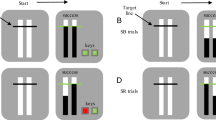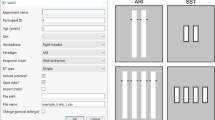Abstract
Have you ever thought about what it means not to act? Basically, most people think about nonactions (or “not responding”) as depending on the existence of a pre-activated response which is then inhibited. The main problem when investigating the characteristics of such no-go responses is that they do not provide reaction times. Importantly, Miller (Psychol Res 70:484–493, 2006) recently showed that in a dual-task paradigm, forced go/no-go decisions in the secondary task lead to a backward crosstalk effect (BCE) in the reaction times of the primary task. Based on this experimental setup, we conducted three experiments to investigate the characteristics of “not responding.” The goal of Experiments 1 and 2 was to compare forced-choice and free-choice no-go responses. In both experiments, we only found a BCE when participants were forced not to respond. We interpret these findings as a first hint that the BCE is not due to an active inhibition of a pre-activated response tendency. Rather, we assume that it is caused by an automatic activation of specific response features when merely perceiving the secondary stimulus (Hommel, J Exp Psychol Hum Percept Perform 24:1368–1384, 1998). In the forced-choice condition, the stimulus unambiguously announces a no-go response. By contrast, this is not the case in the free-choice condition as here the stimulus only signals participants to freely decide to “go” or “not to go.” Therefore, we tested in Experiment 3 rather directly if merely perceiving a stimulus unambiguously announcing a “no-go” causes a BCE. The results confirmed this. Overall, our results suggest that no-go responses do not differ conceptually from go responses.






Similar content being viewed by others
Notes
In the forced-choice condition, 0.1 % of all trials were classified as “short-IRI” trials, 2.9 % as RT1 outliers, and 0.0 % as RT2 outliers. 5.3 % of the trials were excluded due to errors in T1, 2.2 % due to errors in T2. In the free-choice condition 7.8 % of all trials were classified as “short-IRI” trials, 1.2 % as RT1 outliers, and 3.5 % as RT2 outliers. 4.1 % of the trials were excluded due to errors in T1, 0.0 % due to errors in T2 (as it was not possible to commit errors in the free-choice condition). Some trials were excluded due to more than one criterion.
In the forced-choice condition, one participant was excluded because in 55 % of the trials (s)he responded erroneously to S1. In the free-choice condition, two participants were excluded due to their very high “short-IRI” rate (overall 99 %/83 %) which led additionally to missing values in several cells of the design. One participant was excluded because (s)he chose the no-go response only in 15 % of all trials and a fourth participant because her/his mean IRIs exceeded the condition mean by more than 2 SDs.
In detail, 4.7 % of all trials were classified as “short-IRI” trials, 1.3 % as RT1 outliers, and 0.1 % as RT2 outliers. 2.6 % of the trials were excluded due to errors in T1, 3.0 % due to errors in T2. Some trials were excluded due to more than one criterion.
Four participants were excluded because in the free-choice trials they chose one of the two R2 options (go/no-go) in less than 10 % of all trials. This led to missing values in one or more cells of the design. Three participants were excluded mainly due to their very high “short-IRI” rate (ranging from 52 % in forced-choice trials up to 89 % in free-choice trials) which (for two participants) led to missing values in several cells as well. Another two participants were excluded because their mean IRIs (up to overall 850 ms) exceeded the condition mean by more than 2 SDs.
References
Aron, A. R. (2011). From reactive to proactive and selective control: Developing a Richer Model for stopping inappropriate responses. Biological Psychiatry, 69(12), e55–e68.
Berlyne, D. E. (1957). Conflict and choice time. British Journal of Psychology, 48, 106–118.
De Jong, R., Coles, M. H., & Logan, G. D. (1995). Strategies and mechanisms in nonselective and selective inhibitory motor control. Journal of Experimental Psychology: Human Perception and Performance, 21(3), 498–511.
De Jong, R., Coles, M. G., Logan, G. D., & Gratton, G. (1990). In search of the point of no return: The control of response processes. Journal of Experimental Psychology: Human Perception and Performance, 16(1), 164–182.
Donders, F. C. (1868/1969). On the speed of mental processes (original work published 1868). Acta Psychologica, 30, 412–431.
Gomez, P., Ratcliff, R., & Perea, M. (2007). A model of the go/no-go task. Journal of Experimental Psychology: General, 136, 389–413.
Hommel, B. (1998). Automatic stimulus–response translation in dual-task performance. Journal of Experimental Psychology: Human Perception and Performance, 24, 1368–1384.
Hommel, B. (2000). The prepared reflex: Automaticity and control in stimulus-response translation. In S. Monsell & J. Driver (Eds.), Control of cognitive processes: Attention and performance XVIII (pp. 247–273). Cambridge, MA: MIT Press.
Hommel, B., & Eglau, B. (2002). Control of stimulus-response translation in dual-task performance. Psychological Research, 66(4), 260–273.
Hommel, B., Müsseler, J., Aschersleben, G., & Prinz, W. (2001). The theory of event coding (TEC): A framework for perception and action planning. Behavioral and Brain Sciences, 24, 849–937.
Janczyk, M., Dambacher, M., Bieleke, M., & Gollwitzer, P. M. (2015a). The benefit of no choice: Goal-directed plans enhance perceptual processing. Psychological Research, 79(2), 206–220.
Janczyk, M., Nolden, S., & Jolicoeur, P. (2015b). No differences in dual-task costs between forced- and free-choice tasks. Psychological Research, 79(3), 463–477.
Janczyk, M., Pfister, R., Hommel, B., & Kunde, W. (2014). Who is talking in backward crosstalk? Disentangling response- from goal-conflict in dual-task performance. Cognition, 132(1), 30–43.
Kühn, S., Elsner, B., Prinz, W., & Brass, M. (2009). Busy doing nothing: Evidence for nonaction-effect binding. Psychonomic Bulletin and Review, 16(3), 542–549.
Kunde, W. (2001). Response-effect compatibility in manual choice reaction tasks. Journal of Experimental Psychology: Human Perception and Performance, 27(2), 387–394.
Kunde, W., Kiesel, A., & Hoffmann, J. (2003). Conscious control over the content of unconscious cognition. Cognition, 88(2), 223–242.
Lien, M.-C., & Proctor, R. W. (2000). Multiple spatial correspondence effects on dual-task performance. Journal of Experimental Psychology: Human Perception and Performance, 26(4), 1260–1280.
Loftus, G. R., & Masson, M. E. J. (1994). Using confidence intervals in within-subject designs. Psychonomic Bulletin and Review, 1(4), 476–490.
Logan, G. D. (1994). On the ability to inhibit thought and action: A users’ guide to the stop signal paradigm. In D. Dagenbach & T. H. Carr (Eds.), Inhibitory processes in attention, memory, and language (pp. 189–239). San Diego: Academic Press.
Logan, G. D., & Cowan, W. B. (1984). On the ability to inhibit thought and action: A theory of an act of control. Psychological Review, 91(3), 295–327.
Logan, G. D., & Delheimer, J. A. (2001). Parallel memory retrieval in dual-task situations: II. Episodic memory. Journal of Experimental Psychology. Learning, Memory, and Cognition, 27(3), 668–685.
Logan, G. D., & Schulkind, M. D. (2000). Parallel memory retrieval in dual-task situations: I. Semantic memory. Journal of Experimental Psychology: Human Perception and Performance, 26(3), 1072–1090.
Miller, J. (2006). Backward crosstalk effect in psychological refractory period paradigms: Effects of second-task response types on first-task response latencies. Psychological Research, 70, 484–493.
Miller, J., & Durst, M. (2014). “Just do it when you get a chance”: The effects of a background task on primary task performance. Attention, Perception, and Psychophysics, 76(8), 2560–2574.
Paelecke, M., & Kunde, W. (2007). Action-effect codes in and before the central bottleneck: Evidence from the psychological refractory period paradigm. Journal of Experimental Psychology: Human Perception and Performance, 33(3), 627–644.
Pashler, H. (1984). Processing stages in overlapping tasks: Evidence for a central bottle-neck. Journal of Experimental Psychology: Human Perception and Performance, 10(3), 358–377.
Pashler, H. (1994). Dual-task interference in simple tasks: Data and theory. Psychological Bulletin, 116, 220–244.
Prinz, W. (1992). Why don’t we perceive our brain states? European Journal of Cognitive Psychology, 4(1), 1–20.
Sternberg, S. (1969). The discovery of processing stages: Extensions of Donders’ method. Acta Psychologica, 30, 276–315.
Telford, C. W. (1931). The refractory phase of voluntary and associative responses. Journal of Experimental Psychology, 14(1), 1–36.
Verbruggen, F., & Logan, G. D. (2008). Automatic and controlled response inhibition: Associative learning in the go/no-go and stop-signal paradigms. Journal of Experimental Psychology: General, 137(4), 649–672.
Welford, A. T. (1952). The “psychological refractory period” and the timing of high-speed performance—a review and a theory. British Journal of Psychology, 43(1), 2–19.
Wolpert, D. M., Doya, K., & Kawato, M. (2003). A unifying computational framework for motor control and social interaction. Philosophical Transactions of the Royal Society, 358, 593–602.
Acknowledgement
The research reported here was conducted in partial fulfillment of a PhD thesis by Eva Röttger. This work was supported by grants of the German Research Foundation (HA 5447/11-1) and of the Graduate School “Managing Diversity and Transition-Vielfalt und Wandel gestalten” of the Human Sciences Faculty, University of Cologne. We thank Markus Janczyk and a second anonymous reviewer for many helpful comments on an earlier version of this article.
Author information
Authors and Affiliations
Corresponding author
Rights and permissions
About this article
Cite this article
Röttger, E., Haider, H. Investigating the characteristics of “not responding”: backward crosstalk in the PRP paradigm with forced vs. free no-go decisions. Psychological Research 81, 596–610 (2017). https://doi.org/10.1007/s00426-016-0772-3
Received:
Accepted:
Published:
Issue Date:
DOI: https://doi.org/10.1007/s00426-016-0772-3




